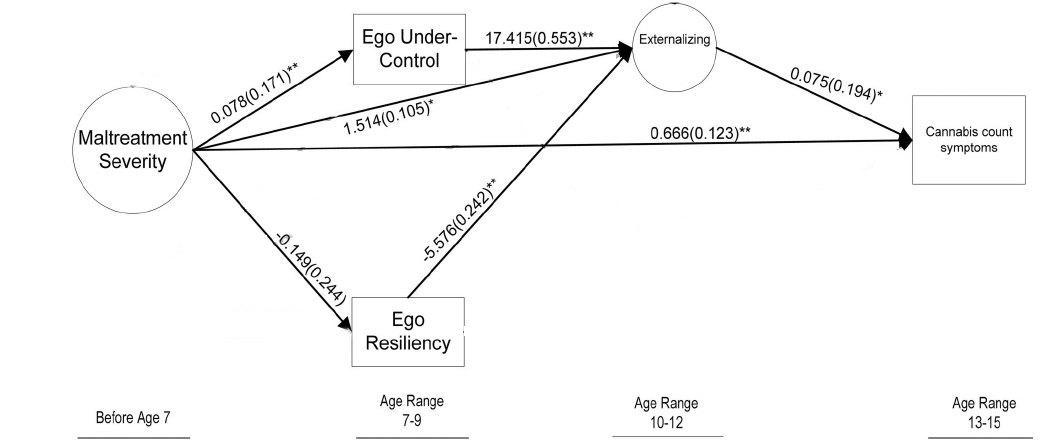STASH, Vol. 7(5) – Pathways from childhood maltreatment to adolescent cannabis abuse
Both childhood maltreatment and personality functioning are linked to adolescent cannabis abuse and dependence (CAD; Oshri, Rogosch, Burnette, & Cicchetti, 2011). However, little is known about the developmental sequence of childhood maltreatment, personality changes, and adolescent CAD. This week’s STASH reviews a longitudinal study that explored (a) the association between childhood maltreatment and its severity as well as individual personality differences, and (b) the extent to which these personality individual differences help explain the connection between childhood maltreatment and adolescent CAD (Oshri, et al., 2011).
Methods
- The research sample consisted of 415 children, 259 of whom experienced maltreatment as indicated by Child Protective Services reports, and 156 of whom reportedly had no maltreatment experiences. These two groups were comparable on socio-demographic characteristics.
- Researchers characterized maltreatment according to severity and type (i.e., neglect, physical abuse, emotional abuse, sexual abuse).
- Researchers tracked and interviewed participants three times from age 7 through age 15.
- Wave 1 occurred when the children were 7-9 years old. The primary measures were ego control (i.e., EC; an individual’s tendency to express emotional impulses) and ego resiliency (i.e., ER; the capacity to adapt one’s level of EC to meet situational needs).
- Wave 2 occurred when the children were 10-12 years old. The primary measures were externalizing and internalizing behaviors. Two camp counselors independently rated children using the Teacher Report Form (Achenbach, 1991).
- Wave 3 occurred when the children were 13-15 years old. Researchers interviewed participants about their current (i.e., past 3 months) CAD using the Diagnostic Interview Schedule for Children (DISC; Shaffer et al., 1993).
- Researchers created and tested a model predicting Wave 3 CAD based on maltreatment severity and type, Wave 1 EC and ER, and Wave 2 internalization and externalization problems.
Results
- As expected, childhood maltreatment was associated with problem behaviors at Wave 2 and CAD symptoms at Wave 3.
- Tests of mediation revealed that EC and ER at Wave 1 significantly mediated the relationship between maltreatment severity and problem behaviors at Wave 2. Externalizing problem behaviors at Wave 2 mediated the relationship between maltreatment severity and CAD symptom count at Wave 3. Figure 1 displays the direct paths of these relationships.

Figure. Structural model of relations among child maltreatment, ego control and ego resiliency, externalizing behaviors, and cannabis abuse and dependence symptoms. Unstandardized and standardized (in parentheses) path coefficients, p < .05. **p < .01. For simplification, we have removed gender and internalizing behavior from this model and we have not depicted the factor compositions of the latent variables (i.e., maltreatment severity and externalizing behavior). For full details, please refer to Oshri et al., 2001, p.7). Click image to enlarge.
Limitations
- Measures focused heavily on peer and observer reports, which might not capture internal experiences accurately and might reflect observer biases.
- The sample included high-risk, economically disadvantaged youth and the results might not generalize to other groups of children.
- The control group might have had unreported childhood maltreatment.
Discussion
Findings suggest that early childhood maltreatment produces less adaptive childhood personality functioning, marked by a diminished ability to control emotional impulses and relatively inflexible emotional coping strategies. These personality changes, in turn, put children at a higher risk for externalizing symptoms and eventual substance abuse and dependence. These results shed light on the developmental pathways linking childhood maltreatment to subsequent substance abuse and dependence. As a result, they might be useful in the development of drug prevention and treatment programs.
– Heather Gray & Daniel Tao
What do you think? Please use the comment link below to provide feedback on this article.
References
Oshri, A., Rogosch, F. A., Burnette, M. L., & Cicchetti, D. (2011). Developmental pathways to adolescent cannabis abuse and dependence: Child mistreatment, emerging personality, and internalizing versus externalizing psychopathology. Psychology of Addictive Behaviors, online first.